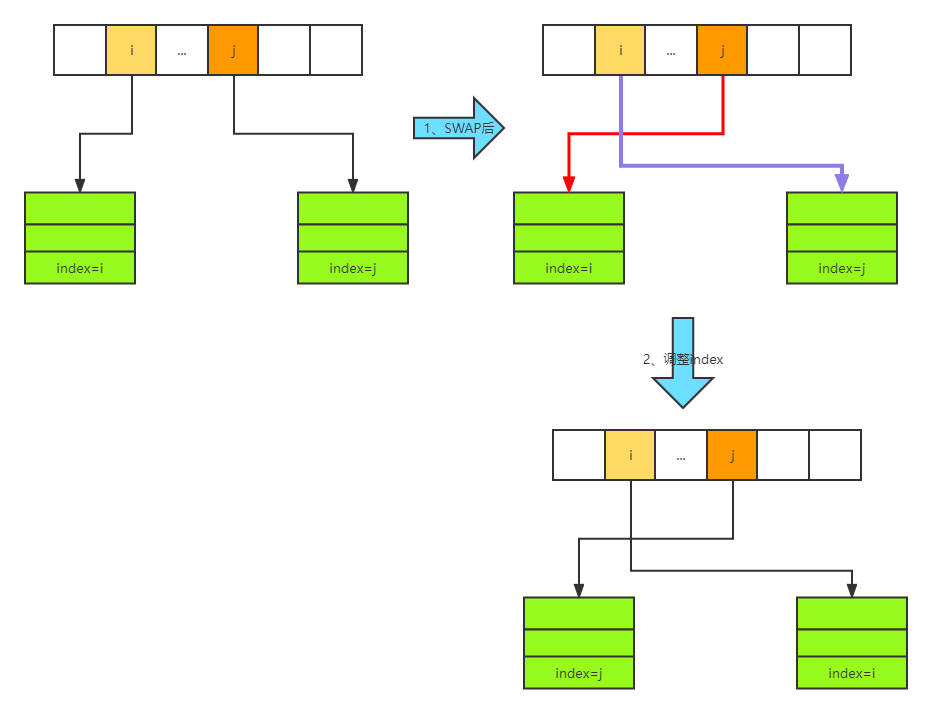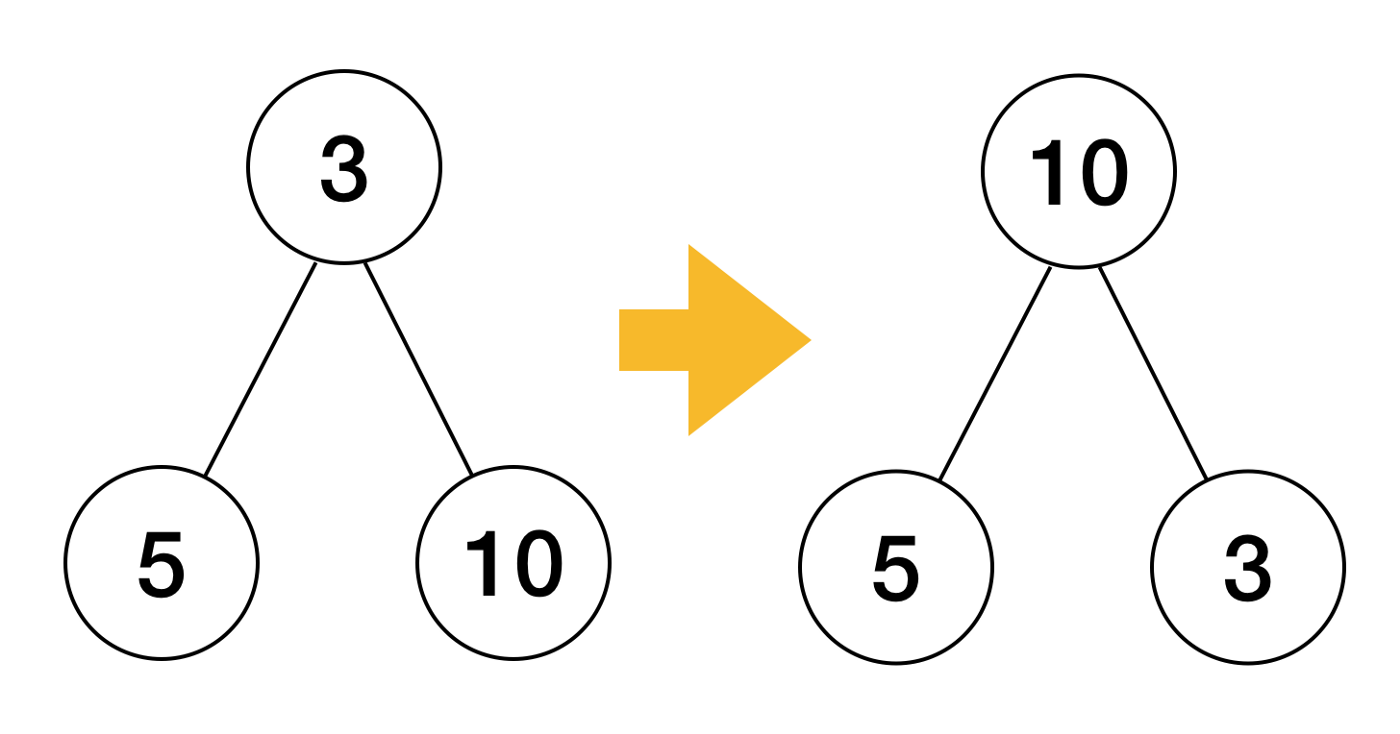0x00 前言
golang 的标准库 container 中,提供了 heap/list/ring 的实现。本文简单分析下实现和应用。
0x01 heap
以 minheap 最小二叉堆为例,堆具有以下特性:
- 任意节点小于它的所有子孙节点,最小节点在堆的根上(堆序性)
- 堆是一棵完全树(complete tree):即除了最底层,其他层的节点都被元素填满,且最底层尽可能地从左到右填入
- 由于堆是完全二叉树,所以可以用顺序数组来表示,如下图


源码分析
标准库的 heap 是一个 interface,因此开发者需要完成三件事:
1、实现相关的接口(共 5 个,包含了 sort.Interface 的 3 个),在源码分析时,特别注意这几个公共接口的嵌入位置
type Interface interface {
sort.Interface // 继承了 sort.Interface,包含了Less/Len/Swap三个方法
Push(x interface{}) // add x as element Len()
Pop() interface{} // remove and return element Len() - 1.
}
2、提供承载数据的slice
这里注意两件事:
- 对于原生结构,如
[]int等,开发者实现的Swap比较简单,直接h[i], h[j] = h[j], h[i]交换即可 - 对于符合结构,如
[]*Item,开发者实现Swap机制有两种选择:- 按照原生方式实现
- 只利用
[]*Item作为存储,在Item加上index成员,充当堆的下标(参考优先级队列的实现),这时Swap就需要考虑Item.index的交换,对应下图

3、以上完成后,可以调用heap库暴露的方法来操作heap(PS:接口都需要传入上述接口的实例化对象)
另外,这里特别注意的是不要混淆heap.Push和自己slice实现的Push方法:
- 开发者实现的
Push方法仅仅是对slice操作 heap.Push调用了slice的Push操作,还需要额外的调整用以维护heap性质
// 建堆, 对heap进行初始化,生成小根堆(或大根堆)
func Init(h Interface)
// 插入元素
func Push(h Interface, x interface{})
// 弹出root元素
func Pop(h Interface) interface{}
// Update元素(包括优先级),从i位置数据发生改变后,对堆再平衡,优先级队列的实现会使用此方法
func Fix(h Interface, i int)
// 删除,从指定位置删除数据,并返回删除的数据,同时亦涉及到堆的再平衡
func Remove(h Interface, i int) interface{}
回想下,minheap 的插入 / 删除过程:
- 向 minheap 中插入
Push一个元素的时候,将此元素插入到最右子树的最后一个节点中,然后调用up向上调整保证最小堆性质 - 从 minheap 中取出堆顶元素(最小的)时,先把该元素和右子树最后一个节点交换,然后
Pop出最后一个节点,然后对根节点调用down方法向下调整保证最小堆性质 - 从 minheap 的任意位置取数据都类似上面的做法
一个容易忽略的点:Swap方法
上面已经讨论,主要涉及到非标准型结构的交换问题
主要方法分析
1、Init方法
Init 为初始化建立 heap 的方法,关键在 heap.down 方法:
- 在
Init方法中,调整的位置,第1个的元素的位置是n/2-1个,符合 minheap 的特性;最后一个位置是堆顶的位置0,保证每个元素都不漏下 heap.down方法的作用是,任选一个元素i,将与其子节点2i+1和2i+2比较,如果i比它的子节点小,则将i与两个子节点中较小的节点交换(代码中的j);子节点j再与它的子节点,继续比较、交换,直到数组末尾、或者待比较的元素比它的两个子节点都小,跳出当前的heap.down循环
// A heap must be initialized before any of the heap operations
// can be used. Init is idempotent with respect to the heap invariants
// and may be called whenever the heap invariants may have been invalidated.
// Its complexity is O(n) where n = h.Len().
//
func Init(h Interface) {
// heapify
n := h.Len() //堆长度,下标从0 ~ n-1
for i := n/2 - 1; i >= 0; i-- {
// 从长度的一半开始,一直到第0个数据,每个位置都调用down方法,down方法实现的功能是保证从该位置往下保证形成堆
down(h, i, n)
}
}
// 给定类型,需要调整的元素在数组中的索引以及 heap 的长度
// 将该元素下沉到该元素对应的子树合适的位置,从而满足该子树为最小堆
func down(h Interface, i0, n int) bool {
i := i0 // 中间变量,初始化保存为:往下调整为heap所在的节点位置
for {
j1 := 2*i + 1 // i节点的左子孩子
if j1 >= n || j1 < 0 { // j1 < 0 after int overflow
// 如果j1 越界了,说明已经调整完成了,可以退出循环
break
}
j := j1 // left child
//中间变量j先赋值为左子孩子,之后j将被赋值为左右子孩子中最小(大)的一个孩子的位置
if j2 := j1 + 1; j2 <n && h.Less(j2, j1) {
j = j2 // = 2*i + 2 // right child
}
//j被赋值为两个孩子中的最小(大)孩子的位置(由开发者实现的Less方法决定)
if !h.Less(j, i) {
// 比较孩子和当前的父亲节点,如果满足堆的要求了,退出循环(注意:j在前,i在后,结果取非)
break
}
h.Swap(i, j) // 否则交换i和j位置的值,继续比较
i = j // 保存j的位置,继续向下调整,保证j位置的子树是heap结构
}
//这个结果有点意思:如果i>i0,说明调整了,返回true;否则,未调整返回false
return i > i0
}

2、Push 方法
Push 方法保证插入新元素时,顺序数组 h 仍然是一个 heap;和上面的描述一致,将 x 元素插入到了数组的末尾位置,再调用 up 方法自下而上进行调整,使其满足 heap 的性质:
heap.up 方法也较易理解:依此(for loop)查找元素 j 的父节点(i),如果 j 比父节点 i 要小,则交换这两个节点,并继续向再上一级的父节点比较,直到根节点,或者元素 j 大于 父节点 i(调整完毕,无需再继续进行)
// Push pushes the element x onto the heap. The complexity is
// O(log(n)) where n = h.Len().
func Push(h Interface, x interface{}) {
// 将新插入进来的节点放到最后(调用开发者封装的Push)
h.Push(x)
// 自下而上调整
up(h, h.Len()-1)
}
func up(h Interface, j int) {
for {
i := (j - 1) / 2 // parent(j节点的父节点)
if i == j || !h.Less(j, i) {
// 如果越界,或者满足堆的条件(使用开发者实现的Less方法),则结束for循环
break
}
// 否则将该节点和父节点交换,继续下一轮比较
h.Swap(i, j)
j = i // 交换当前位置,对父节点继续进行检查直到根节点
}
}
3、Pop 方法
heap.Pop 方法是取出堆顶位置的数据(minheap 为最小),取完数据之后,heap 肯定不平衡。所以通常的做法是:将根节点(0 位置)与末尾节点的元素交换,并将新的根节点的元素(先前的最后一个元素)down 自上而下调整到合适的位置,满足最小堆的要求;
最后再调用用户自定义的 Pop 函数获取最后一个元素即可
这里需要区分 heap 包的 Pop 方法和用户自定义实现的 Pop 方法的根本区别,用户的 Pop 方法只是用来获取数据的
// Pop removes the minimum element (according to Less) from the heap
// and returns it. The complexity is O(log(n)) where n = h.Len().
// It is equivalent to Remove(h, 0).
func Pop(h Interface) interface{} {
// 把最后一个节点和第一个节点进行交换,之后,从根节点开始重新保证堆结构,最后把最后那个节点数据丢出并返回
n := h.Len() - 1
h.Swap(0, n)
down(h, 0, n)
return h.Pop()
}
4、Remove 方法
Remove 方法提供了删除指定位置 index 元素的实现,即先将要删除的节点 i 与末尾节点 n 交换,然后将新的节点 i 下沉或上浮到合适的位置(通俗的说,由于新数据调整,原先末尾的位置升到了它不该在的位置,需要调整这个元素,先一路 down 到底,然后再一路 up 到最终的位置)
// Remove removes the element at index i from the heap.
// The complexity is O(log(n)) where n = h.Len().
//
func Remove(h Interface, i int) interface{} {
n := h.Len() - 1
if n != i {
//Pop只是Remove的特例
//Remove是把i位置的节点和最后一个节点进行交换,之后保证从i节点往下及往上都保证堆结构,最后把最后一个节点的数据返回
h.Swap(i, n)
if !down(h, i, n) {
up(h, i)
}
}
return h.Pop()
}
5、Fix 方法
Fix 方法的意义是在优先级队列的场景(从 i 位置数据发生改变后,对 heap 再平衡,优先级队列会使用本方法)。即当i节点的比较值发生改变后,需要保证heap的再平衡:先调用down保证该节点下面的堆结构,如果有位置交换,则需要保证该节点往上的堆结构,否则就不需要往上保证堆结构(没有调整影响另一侧的话,肯定是平衡的),这里画个图,非常容易理解。
// Fix re-establishes the heap ordering after the element at index i has changed its value.
// Changing the value of the element at index i and then calling Fix is equivalent to,
// but less expensive than, calling Remove(h, i) followed by a Push of the new value.
// The complexity is O(log(n)) where n = h.Len().
func Fix(h Interface, i int) {
if !down(h, i, h.Len()) {
up(h, i)
}
}
heap 实例化
下面使用 []int 的 slice 结构来实现一个 heap,注意调用方式采用 heap 包的方法进行调用:
type IntHeap []int
func main() {
h := &IntHeap{2, 1, 5, 13,11, 4, 3, 7, 9, 8, 0}
heap.Init(h) // 将数组切片进行堆化
fmt.Println(*h)
fmt.Println(heap.Pop(h)) // 调用 pop 0 返回移除的顶部最小元素
heap.Push(h, 6) // 添加一个元素进入堆中进行堆化
for len(*h) > 0 {
fmt.Printf("%d \n", heap.Pop(h))
}
}
func (h IntHeap) Len() int { return len(h) }
func (h IntHeap) Less(i, j int) bool { return h[i] < h[j] } //minheap
//交换两个元素位置
func (h IntHeap) Swap(i, j int) {
h[i], h[j] = h[j], h[i]
}
func (h *IntHeap) Pop() interface{} {
old := *h
n := len(old)
// 将顶小堆元素与最后一个元素交换位置,在进行堆排序的结果
x := old[n-1]
*h = old[0 : n-1]
return x
}
// 实现 Push 方法,插入新元素
func (h *IntHeap) Push(x interface{}) {
*h = append(*h, x.(int))
}
heap 的应用
- 定时器
- 优先级队列:比如kubernetes中的实现,FIFO-PriorityQueue
- heap排序
这里使用 heap 实现优先级队列,如下定义,调用代码在此:
// An Item is something we manage in a priority queue.
type Item struct {
value string // 优先级队列中的数据
priority int // The priority of the item in the queue.
// The index is needed by update and is maintained by the heap.Interface methods.
// index是该节点在堆中的位置,这里采用所说的复合结构,注意Swap操作
index int // The index of the item in the heap.
}
// A PriorityQueue implements heap.Interface and holds Items.
type PriorityQueue []*Item
func (pq PriorityQueue) Len() int { return len(pq) }
func (pq PriorityQueue) Less(i, j int) bool {
// We want Pop to give us the highest, not lowest, priority so we use greater than here.
return pq[i].priority > pq[j].priority
}
func (pq PriorityQueue) Swap(i, j int) {
pq[i], pq[j] = pq[j], pq[i]
// pq[i].index = i
// pq[j].index = j
//pq[j].index,pq[i].index = pq[i].index,pq[j].index
pq[i].index, pq[j].index = i, j
}
func (pq *PriorityQueue) Push(x interface{}) {
n := len(*pq)
item := x.(*Item)
item.index = n
*pq = append(*pq, item)
}
func (pq *PriorityQueue) Pop() interface{} {
old := *pq
n := len(old)
item := old[n-1]
//将index置为-1是为了标识该数据已经出了优先级队列
item.index = -1 // for safety
*pq = old[0 : n-1]
return item
}
// update modifies the priority and value of an Item in the queue.
// 更新优先级队列中某个指定item的优先级,涉及到heap的再平衡,本操作修改了优先级和值的item在优先级队列中的位置
func (pq *PriorityQueue) update(item *Item, value string, priority int) {
item.value = value
item.priority = priority
heap.Fix(pq, item.index)
}
与上例子不同的是,优先级队列有个update方法,该方法用以实时调整heap某个元素的priority,调整之后会触发heap.Fix方法对heap进行重排序以达到heap的特性
小结
使用标准库的heap,需要明确这几项:
- 定义自己的接口,实现heap所需要的方法
- 注意package的方法,和结构体的方法,虽然同名,但是功能完全不一样
heap.Fix、heap.Remove方法的使用场景
0x02 list包
container/list包,有两个暴露对外部的结构:
List:List 实现了一个双向链表Element:Element 代表了链表中元素的结构
注意,List是可以做到开箱即用的,看下面List对外的方法,参数均为interface{} 类型;
// List represents a doubly linked list.
// The zero value for List is an empty list ready to use.
type List struct {
//链表的根元素
root Element // sentinel list element, only &root, root.prev, and root.next are used
//链表的长度
len int // current list length excluding (this) sentinel element
}
// Element is an element of a linked list.
type Element struct {
// Next and previous pointers in the doubly-linked list of elements.
// To simplify the implementation, internally a list l is implemented
// as a ring, such that &l.root is both the next element of the last
// list element (l.Back()) and the previous element of the first list
// element (l.Front()).
next, prev *Element // 前/后元素指针
// The list to which this element belongs.
list *List //元素所在的链表
// The value stored with this element.
Value any //这个any是interface{},用来存储元素值
}
list的使用
func main() {
//创建List
var l = list.New()
e0 := l.PushBack(1)
e1 := l.PushFront(3)
e2 := l.PushBack(7)
l.InsertBefore(3, e0)
l.InsertAfter(196, e1)
l.InsertAfter(829, e2)
for e := l.Front(); e != nil; e = e.Next() {
fmt.Printf("%#v\n", e.Value.(int))
}
}
Element的方法
func (e *Element) Next() *Element // 返回该元素的下一个元素,如果没有下一个元素则返回 nil
func (e *Element) Prev() *Element // 返回该元素的前一个元素,如果没有前一个元素则返回 nil
List的方法
func New() *List // 构造一个初始化的list
func (l *List) Back() *Element // 获取list l的最后一个元素
func (l *List) Front() *Element // 获取list l的最后一个元素
func (l *List) Init() *List // list l 初始化或者清除 list l
func (l *List) InsertAfter(v interface{}, mark *Element) *Element // 在 list l 中元素 mark 之后插入一个值为 v 的元素,并返回该元素,如果 mark 不是list中元素,则 list 不改变
func (l *List) InsertBefore(v interface{}, mark *Element) *Element // 在 list l 中元素 mark 之前插入一个值为 v 的元素,并返回该元素,如果 mark 不是list中元素,则 list 不改变
func (l *List) Len() int // 获取 list l 的长度
func (l *List) MoveAfter(e, mark *Element) // 将元素 e 移动到元素 mark 之后,如果元素e 或者 mark 不属于 list l,或者 e==mark,则 list l 不改变
func (l *List) MoveBefore(e, mark *Element) // 将元素 e 移动到元素 mark 之前,如果元素e 或者 mark 不属于 list l,或者 e==mark,则 list l 不改变
func (l *List) MoveToBack(e *Element) // 将元素 e 移动到 list l 的末尾,如果 e 不属于list l,则list不改变
func (l *List) MoveToFront(e *Element) // 将元素 e 移动到 list l 的首部,如果 e 不属于list l,则list不改变
func (l *List) PushBack(v interface{}) *Element // 在 list l 的末尾插入值为 v 的元素,并返回该元素
func (l *List) PushBackList(other *List) // 在 list l 的尾部插入另外一个 list,其中l 和 other 可以相等
func (l *List) PushFront(v interface{}) *Element // 在 list l 的首部插入值为 v 的元素,并返回该元素
func (l *List) PushFrontList(other *List) // 在 list l 的首部插入另外一个 list,其中 l 和 other 可以相等
func (l *List) Remove(e *Element) interface{} // 如果元素 e 属于list l,将其从 list 中删除,并返回元素 e 的值
List的问题(注意)
- 不要使用自己构造的Element结构,作为参数传入List的方法
Remove方法是传入指定位置的元素(list的Remove实现),复杂度是O(1),需要开发者保存对应的element的指针(地址)- 若在goroutine并发环境下使用
container/list链表,那么需要加锁 - List并未提供
Pop类方法,需要自行组合实现,不过需要加锁 - List如何正确删除所有元素?
- List包中大部分对于
e *Element进行操作的元素都可能会导致程序崩溃,其根本原因是e是一个Element类型的指针,当然其也可能为nil,但是golang中list包中函数没有对其进行是否为nil的检查,变默认其非nil进行操作,所以这种情况下,便可能出现程序崩溃
1、Remove的实现
// Remove removes e from l if e is an element of list l.
// It returns the element value e.Value.
// The element must not be nil.
func (l *List) Remove(e *Element) any {
if e.list == l {
// if e.list == l, l must have been initialized when e was inserted
// in l or l == nil (e is a zero Element) and l.remove will crash
l.remove(e)
}
return e.Value
}
// remove removes e from its list, decrements l.len
func (l *List) remove(e *Element) {
e.prev.next = e.next
e.next.prev = e.prev
e.next = nil // avoid memory leaks
e.prev = nil // avoid memory leaks
e.list = nil
l.len--
}
2、Pop方法实现
List的典型应用场景
List的坑
1、删除List中的所有元素
先列举一个删除(所有节点)有问题的代码,未能全部删除链表中的节点:
func main() {
l := list.New()
l.PushBack(1)
l.PushBack(2)
l.PushBack(3)
l.PushBack(4)
//遍历list,删除元素
for e := l.Front(); e != nil; e = e.Next() {
fmt.Println("removing", e.Value)
l.Remove(e)
}
fmt.Println("After Removing...")
//遍历删除完元素后的list
for e := l.Front(); e != nil; e = e.Next() {
fmt.Println(e.Value)
}
}
从list.Remove的实现排查原因,注意到返回被删除的Element时,会将e.next = nil,所以问题来源于此,需要在上述代码中先临时保存e.next,再用于后续逻辑:
// remove removes e from its list, decrements l.len, and returns e.
func (l *List) remove(e *Element) *Element {
e.prev.next = e.next
e.next.prev = e.prev
e.next = nil // avoid memory leaks
e.prev = nil // avoid memory leaks
e.list = nil
l.len--
return e
}
调整后的代码如下:
func main() {
l := list.New()
l.PushBack(1)
l.PushBack(2)
l.PushBack(3)
l.PushBack(4)
var n *list.Element
for e := l.Front(); e != nil; e = n {
//save next
n = e.Next()
l.Remove(e)
}
for e := l.Front(); e != nil; e = e.Next() {
fmt.Println(e.Value)
}
}
2、List大部分方法不检查传入参数为nil
从list包各个方法的实现来看,大部分针对e *Element进行操作的元素都可能会导致程序崩溃,原因是e *Element可能为nil,大部分方法没有对此值进行是否为nil的检查,所以可能出现Core问题,此时需要开发者自行解决健壮性问题。
如下例子:
//list中只有1个元素,但是要删除2个元素
func DelElement() {
l := list.New()
l.PushBack(1)
fmt.Println(l.Front().Value)
value := l.Remove(l.Front())
fmt.Println(value)
value1 := l.Remove(l.Front()) //panic: runtime error: invalid memory address or nil pointer dereference
fmt.Println(value1)
}
Core的原因,看下list.Remove实现便知,list.Remove方法没有对参数进行是否为nil的检查:
func (l *List) Front() *Element {
if l.len == 0 {
//返回nil
return nil
}
return l.root.next
}
func (l *List) Remove(e *Element) interface{} {
if e.list == l {
// if e.list == l, l must have been initialized when e was inserted
// in l or l == nil (e is a zero Element) and l.remove will crash
l.remove(e)
}
return e.Value
}
3、List并发:需要加锁
如下面的例子,会core掉。(l *list)PushBackList(other *list)的实现方式是other *list中元素添加在l list的后面,实现是取出other中所有元素,将其顺次挂载在l中。
//将ls中元素添加到l过程中,如果ls中元素减少,程序便会崩溃
func main() {
runtime.GOMAXPROCS(8)
l := list.New()
ls := list.New()
for i := 0; i < 10000; i++ {
ls.PushBack(i)
}
go ls.Remove(l.Back())
l.PushBackList(ls) //invalid memory address or nil pointer dereference
}
PushBackList的实现如下:首先获取other的长度n,然后循环n次取出其元素将其插入l中。问题出现在循环n次时若过程中other的元素变化(假设其中有些元素被删除),这就导致e的指针可能为nil,此时使用e.Value取值,程序便会崩溃
func (l *List) PushBackList(other *List) {
l.lazyInit()
for i, e := other.Len(), other.Front(); i > 0; i, e = i-1, e.Next() {
l.insertValue(e.Value, l.root.prev)
}
}
所以项目中对list并发操作时需要加写锁
0x03 ring包
container/ring 实现了环形链表的功能,其典型应用场景是构造定长环形队列,比如用来保存固定size的元素,如最近N条日志等。Ring的结构如下:
type Ring struct {
next *Ring
prev *Ring
Value interface{}
}
ring的典型用法
func main() {
// 创建一个环, 包含 3 个元素
r := ring.New(3)
fmt.Printf("ring: %+v\n", *r)
// 初始化
for i := 1; i <= 3; i++ {
r.Value = i
r = r.Next()
}
fmt.Printf("init ring: %+v\n", *r)
// sum
s := 0
r.Do(func(i interface{}) {
fmt.Println(i)
s += i.(int)
})
fmt.Printf("sum ring: %d\n", s)
}
Ring可调用的方法
func New(n int) *Ring // 用于创建一个新的 Ring, 接收一个整形参数,用于初始化 Ring 的长度
func (r *Ring) Len() int // 环长度
func (r *Ring) Next() *Ring // 返回当前元素的下个元素
func (r *Ring) Prev() *Ring // 返回当前元素的上个元素
func (r *Ring) Move(n int) *Ring // 指针从当前元素开始向后移动或者向前(n 可以为负数)
// Link & Unlink 组合起来可以对多个链表进行管理
func (r *Ring) Link(s *Ring) *Ring // 将两个 ring 连接到一起 (r 不能为空)
func (r *Ring) Unlink(n int) *Ring // 从当前元素开始,删除 n 个元素
func (r *Ring) Do(f func(interface{})) // Do 会依次将每个节点的 Value 当作参数调用这个函数 f, 实际上这是策略方法的引用,通过传递不同的函数以在同一个 ring 上实现多种不同的操作。
Ring数据结构的应用场景
- 构造定长环回队列,如保存固定长度的数据等
- 用作固定长度的对象缓冲区(参见goim的数据结构分析)
Ring VS List
Ring 和 List 的区别如下:
- Ring 类型的数据结构仅由它自身即可代表,而 List 类型则需要由它以及 Element 类型联合表示
- 一个 Ring 类型的值严格来讲,只代表了其所属的循环链表中的一个元素,而一个 List 类型的值则代表了一个完整的链表
- 在创建并初始化一个 Ring 时,可以指定它包含的元素数量,但是对于一个 List 值来说却不需要。循环链表一旦被创建,其长度是不可变的
- 通过
var r ring.Ring声明的r将会是一个长度为1的循环链表,而 List 类型的零值则是一个长度为0的链表。)(List 中的根元素不会持有实际元素的值) - Ring 的
Len方法的算法复杂度是O(N),而 List 的Len算法复杂度是O(1)
ring的典型应用场景
0x04 番外:go-zero提供的数据结构
queue(FIFO)
Queue是go-zero提供的先进先出的安全队列
1、结构
// A Queue is a FIFO queue.
type Queue struct {
lock sync.Mutex
elements []interface{} //存储
size int
head int
tail int
count int
}
2、操作方法:Put和Take
// Put puts element into q at the last position.
func (q *Queue) Put(element interface{}) {
q.lock.Lock()
defer q.lock.Unlock()
if q.head == q.tail && q.count > 0 {
nodes := make([]interface{}, len(q.elements)+q.size)
copy(nodes, q.elements[q.head:])
copy(nodes[len(q.elements)-q.head:], q.elements[:q.head])
q.head = 0
q.tail = len(q.elements)
q.elements = nodes
}
q.elements[q.tail] = element
q.tail = (q.tail + 1) % len(q.elements)
q.count++
}
// Take takes the first element out of q if not empty.
func (q *Queue) Take() (interface{}, bool) {
q.lock.Lock()
defer q.lock.Unlock()
if q.count == 0 {
return nil, false
}
element := q.elements[q.head]
q.head = (q.head + 1) % len(q.elements)
q.count--
return element, true
}
set:集合
Set提供了集合的实现
Set结构主要是map为基准,核心在于实现存储key值interface{}的通用性,此外还需要实现交集、并集、补集、差集等实现
// Set is not thread-safe, for concurrent use, make sure to use it with synchronization.
type Set struct {
data map[interface{}]lang.PlaceholderType
tp int
}